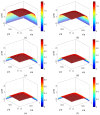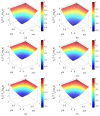Thermally Fully Developed Electroosmotic Flow of Power-Law Nanofluid in a Rectangular Microchannel
- PMID: 31151264
- PMCID: PMC6631849
- DOI: 10.3390/mi10060363
Thermally Fully Developed Electroosmotic Flow of Power-Law Nanofluid in a Rectangular Microchannel
Abstract
The hydrodynamic and thermal behavior of the electroosmotic flow of power-law nanofluid is studied. A modified Cauchy momentum equation governing the hydrodynamic behavior of power-law nanofluid flow in a rectangular microchannel is firstly developed. To explore the thermal behavior of power-law nanofluid flow, the energy equation is developed, which is coupled to the velocity field. A numerical algorithm based on the Crank-Nicolson method and compact difference schemes is proposed, whereby the velocity, temperature, and Nusselt number are computed for different parameters. A larger nanoparticle volume fraction significantly reduces the velocity and enhances the temperature regardless of the base fluid rheology. The Nusselt number increases with the flow behavior index and with electrokinetic width when considering the surface heating effect, which decreases with the Joule heating parameter. The heat transfer rate of electroosmotic flow is enhanced for shear thickening nanofluids or at a greater nanoparticle volume fraction.
Keywords: Joule heating parameter; compact difference scheme; electroosmotic flow; heat transfer; nanoparticle volume friction; power-law nanofluid.
Conflict of interest statement
The author declares no conflict of interest.
Figures










References
-
- Stone H.A., Stroock A.D., Ajdari A. Engineering flows in small devices. Ann. Rev. Fluid Mech. 2004;36:381–411. doi: 10.1146/annurev.fluid.36.050802.122124. - DOI
-
- Bruus H. Theoretical Microfluidics. Oxford University Press; New York, NY, USA: 2008.
-
- Zeng S., Chen C.H., Mikkelsen J.C., Jr., Santiago J.G. Fabrication and characterization of electroosmotic micropumps. Sens. Actuators B. 2001;79:107–114. doi: 10.1016/S0925-4005(01)00855-3. - DOI
-
- Horiuchi K., Dutta P. Joule heating effects in electroosmotically driven microchannel flows. Int. J. Heat Mass Transf. 2004;47:3085–3095. doi: 10.1016/j.ijheatmasstransfer.2004.02.020. - DOI
-
- Das S., Chakraborty S. Analytical solutions for velocity, temperature and concentration distribution in electroosmotic microchannel flows of a non-newtonian bio-fluid. Anal. Chim. Acta. 2006;559:15–24. doi: 10.1016/j.aca.2005.11.046. - DOI
Grants and funding
LinkOut - more resources
Full Text Sources

